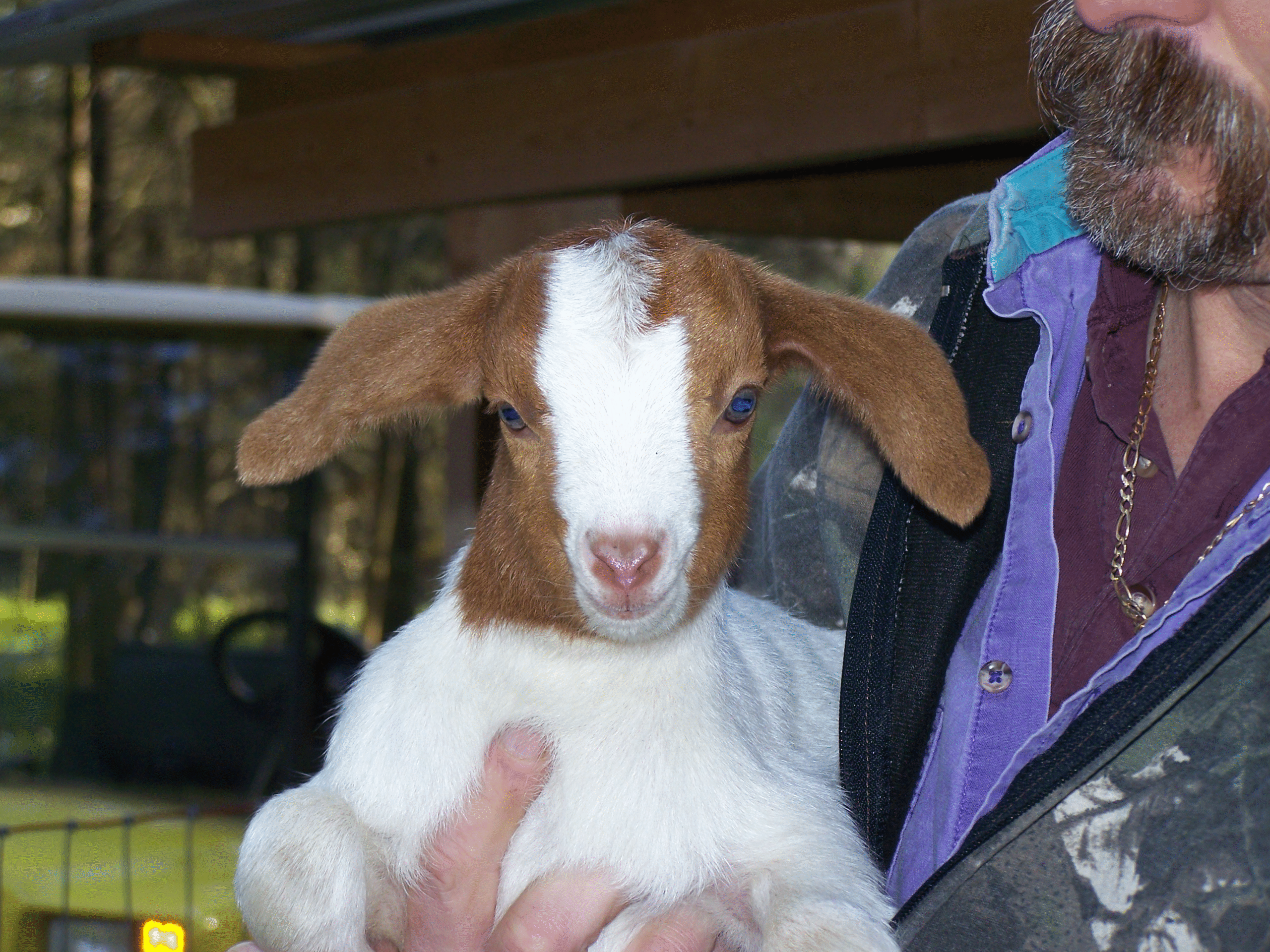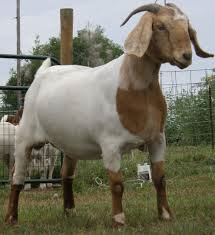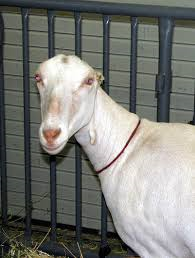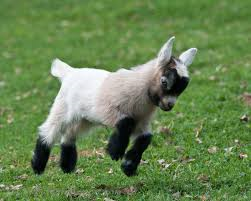Goats:
Goats can be a great animal to add to your farm. They’re easy to handle and produce lots of delicious and healthful milk as well as low-fat meat. Plus, goat manure makes great fertilizer.
Should You Raise Goats?
One doe will produce 90 quarts of fresh milk every month for 10 months of the year, with two months off right before she gives birth. That said, you can’t keep just one doe – you’ll need to keep two goats, a doe and a wether, or two does, at a minimum, so they don’t get lonely.
Each castrated male goat, or meat wether, will produce 25 to 40 pounds of meat. And each bred doe will give birth to, at minimum, one kid annually.
Goats don’t need fussy housing, but they do require some serious fencing to keep them where they belong. They will graze pasture but are great browsers, who will eat bushes and other brush. Dairy goats will require some hay and commercial goat feed, though, too, so you’ll need to be prepared to feed them. Meat goats do well on just hay and browse, unless they’re nursing or growing kids.
Raising Goats for Milk or Meat
Like cattle, goats can be used for either milk or meat production. They can also be used for wool and hair production, although because these breeds have such thick coats, most farmers in Tennessee, where it can get very hot in the summer, still mostly use sheep for this latter purpose.
Goat meat is not a typical staple in most of Tennessee, and is not commonplace in the US in general. But there is a demand for it from certain religious and cultural groups who predominantly eat it, and it can be a profitable niche if you find the right market. There is in fact such a demand that goat meat must be imported into the US every year. It’s fairly easy to keep dairy goats and raise the bucks for meat, since you have to breed your does to keep them in milk and roughly half of all kids are male. However, the Boer is the main meat breed in the US, primarily raised for meat not milk. Another option is to breed your milking goats to Boers or another meat breed to produce crossbred kids for meat, while still keeping does for milk.
Housing and Fencing Goats
Goat housing is simple: just keep them dry and draft-free and they are happy. A three-sided structure is enough for mild climates. It’s helpful to have a small stall for isolating a sick or injured goat or for a pregnant goat to give birth. Packed dirt will suffice for a floor in the goat house, but it should be covered with a thick layer of bedding: wood shavings (not cedar), straw, or waste hay. Since hay is goats’ primary food and they tend to waste up to one-third of it, you can pitch the waste hay into the bedding area each day, saving money. Keep bedding clean and dry, spreading new layers on top and removing and replacing all of it as needed.
Fencing is a little more complex. Goats need a very strong fence that they can’t climb over, knock down or otherwise escape from. If there is so much as a tiny hole, they will find a way to get out. They use their lips to explore their world, so if a gate latch is loose, they can wiggle it open with their lips and escape. They also chew almost everything – rope, electrical wiring, and so on, are all fair game. And goats can jump and climb. Your goat house should have a climbing-proof roof.
High-tensile, smooth electrified wire is ideal if you want to take an existing fence and make it goat-proof. You can use a nonelectric fence at least four feet high, five feet for active breeds like Nubians. Brace corners and gates on the outside so the goats can’t climb up the braces. You can use wooden fencing, stock panels, or chain-link fence, or you can combine a wooden rail fence with woven wire.
Feeding Goats
Goats can be pastured on grass or browse in the woods, eating shrubs and young trees. It’s important to rotate goats to new pasture so that they graze it evenly and don’t foul it up, which can lead to a buildup of parasites.
Goats require additional hay even when they have pasture, as they can’t eat all fresh grass. You can feed hay free choice – give them as much as they desire. Young goats and pregnant or milk-producing does require some goat “concentrate,” or goat chow.
Goats are super fun to have around the farm, as they tend to have very definite personalities. We have three goats on our property. We had more, but the coyotes sadly killed all the babies one year and we haven’t had the heart to start another herd. Donkeys and mules are often pastured with other livestock, as they are an amazing defense against coyotes. Llamas are interestingly also good as anti-predator animals.
We are investigating the possibility of fostering a donkey. They could protect our kid goats and the feed can be tax deductible…a win win.
Goats are typically frisky and energetic, and have a great ability to forage and adapt to almost any environment. They are easy to manage and very low maintenance. You can raise them without any supplemental feeding, but as with cattle this somewhat depends on the grass mixtures on your property. Yes, goats will eat garbage, and could potentially eat the tin can they find lying around, but it won’t get any nutrients from it. They will clear the brush and clear your garbage, but you do want to ensure they are getting good nutrition as well.
One thing you need to watch out for is if you have hemlock on your property, goats will eat it and it will kill them. They will pretty much eat anything, including shirts (while being worn), hair (while on your head), and any stuff you have on your hair.
Meat Breeds:
Boer: We have Boer mix goats. These can grow to be very large (recall how beef cattle tend to have large bodies as well). Boer goats tend to have full white bodies, with darker heads, and long droopy ears. Just as an aside, it can sometimes be hard to goats and sheep apart. Goats’ tails go up, and wag upright, while sheep tails hang down. Goat tails are also typically longer, and sheep tails are what we call “docked.” This is because since they hang down they can get a lot of fecal matter on it, so their tails are cut at a very young age to prevent this.
Boer goats are probably the most popular meat breed in the world, not just in the US. They have a really fast growth rate, and high fertility, which is good both in terms of turnaround of investment and if you suffer herd culling from predators. The quality of the meat is typically very high and like many goats these have an increased resistance to disease. Vaccinating your goats is still optimal, but there is a lower risk of them getting sick than is the case with other animals such as horses and cows.
Goats are usually friendly, although they can be more territorial if they have a lot of kids around, in which case take a branch with you and smack them on the head if they get too belligerent. This might sound a little mean, but you have to show goats who is boss, and, in their eyes, be the goat who isn’t backing down.
Kiko: They are pretty common in Tennessee. Generally very Large-framed, all white, hardy and able to thrive under poor conditions, the Kiko was developed in New Zealand and brought to the US in the 1990s. They are a bit friskier than the Boers, and are known for substantial weight gain without any supplemental feeding.
If you have a lot of range available, Kikos may be a more economical breed than Boers for you to raise.
Spanish:
Before Boer goats became popular in the US in the late 1980s, Spanish goats were the standard meat-goat breed, especially in the South. They are so named because they are descended from goats first introduced to the Americas by Spanish explorers. They were originally bred for brush and pasture maintenance, but then due to selection they became mixed with other breeds to become a meat breed. They’re medium-sized and lanky, mostly short-haired, and come in all colors. Don’t need a lot of supplemental feeding and can breed out of season. This means a higher production of kids (like, everywhere). They have long, often twisty horns.
Dairy Breeds:
The three most popular dairy goat breeds (though there are others) in the US are the La Mancha, Nubian, and Toggenburg.
La Mancha
These are friendly goats that come in a variety of colors and patterns, La Manchas usually have small ears (sometimes so small as to be unnoticeable) of two types: gopher ears, small and rounded, or slightly larger ears, shorter than two inches, that some people call “elf ears.”
This is one of the smaller dairy breeds, but they tend to be very high milk producers. They are very popular in Middle Tennessee, and you’ll find them at many county fairs.
Nubian
Nubian goats are one of the most popular dairy breeds in the world, and the most popular American dairy breed. With their floppy, long ears and rounded, convex noses (called “Roman” noses), they are large goats producing a rich milk high in butterfat. Goat-cheese makers often choose Nubian milk because of this quality. They don’t produce the same volume of milk as the La Manchas, but they’re sometimes called “the Jerseys of the dairy goat world,” because like Jersey cows, they produce a milk so high in protein and butterfat.
One thing to be aware of that Nubians can be very loud, and they have a distinctive cry that may annoy your neighbors. They are also not quite as manageable as other more docile breeds.
Toggenberg:
Toggenburg goats, or Toggs, as they are sometimes called, are a very sweet-tempered, medium-sized breed, coming in a variety of colors: from light brown to chocolate. They are known for having attractive markings such as white-sided tails, white muzzles, white ears, and two stripes down the face. They are one of the only dairy breeds with erect ears, and tend to be a little shaggier than the other more straight-coated breeds. Spirited and playful, Toggs are average milk volume producers (lower than La Manchas, for instance), and their milk is lower fat than the Nubians. But they have extra long lactation periods, which means they provide milk for more days in the year.
Goat milk is very different than any kind of cow’s milk. It’s a different, stronger flavor, thickness and texture. Feta and goat cheeses are made from goat’s milk, as is the white queso dip you see at many Mexican restaurants.
The full pasteurization process (for both cattle and goats) is very involved and beyond the scope of this book. It is possible to drink unpasteurized milk, but its important to remember that there is a risk of bacterial contamination (from bacteria already present in the milk), which can lead to infection of us humans if you do this.
“Fun” Breeds:
Pygmy Goats:
Pygmy goats are highly domesticated and are mostly pets, but they are actually officially listed as meat goats because they have a compact and meaty body and are fertile out of season. They are very energetic, and very entertaining to watch, and a lot of fun. They do tend to poop when and where they want, but the upside is their poop is pellet-like, and very easy to clean up.
Tennessee Fainting Goats:
Tennessee Fainting goats are, in fact, from Tennessee and are also called myotonic goats, Nervous goats, Wooden goats or Stiff Leg goats.
When startled, these goats go rigid and “faint” or fall down. This is actually a painless genetic disorder that has been intentionally perpetuated by breeding (for reasons I can only guess being to serve the demographic that enjoys seeing goats fall over).
If you have these goats, you do need to keep them confined, because they are easy prey for predators (fainting and falling down is not a great survival strategy when the coyotes are coming). Myotonic goats are hardy, fertile, and have a long breeding season.
Standard Care of Goats:
Despite their general hardiness, goats can be susceptible to certain strains of Clostridium bacteria, and also tetanus and there are core vaccines for these.
As with other animals, you will need to worry about flies and ticks, as well as intestinal parasites. The number one intestinal parasite of goats is called Haemoncus contortus, otherwise known as the Barber pole worm. This is an almost ubiquitous worm that is found in almost every goat, and which can be fatal, so treatment must be followed per your local veterinarian.
Yes, there is a lot to consider when raising goats….
To learn more about farm animals and sustainable living click the link below:





